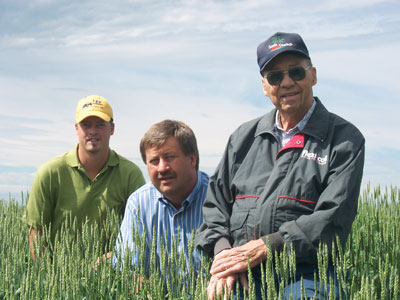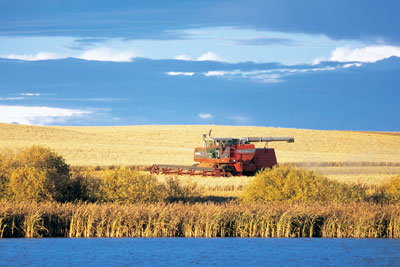
Features
Agronomy
Cereals
Take the bottlenecks out of winter wheat seeding
Winter wheat is a profitable option for many growers in Western Canada, adding diversity to rotations and spreading the workload over the cropping season. However, planning ahead and being well prepared is necessary. “Planning in advance is the key to facilitating seeding of winter wheat and easing the pressure during the busy harvest season,” says Melissa Stanford, conservation program specialist with Ducks Unlimited Canada in Lethbridge, Alberta. “Ideally planning should start in the spring, with the earliest seeded crops likely the fields that will be seeded to winter wheat in the fall. Along with seeding early, choosing early maturing varieties will help to have stubble available earlier in the fall.”
May 3, 2010 By Donna Fleury
Winter wheat is a profitable option for many growers in Western Canada, adding diversity to rotations and spreading the workload over the cropping season. However, planning ahead and being well prepared is necessary. “Planning in advance is the key to facilitating seeding of winter wheat and easing the pressure during the busy harvest season,” says Melissa Stanford, conservation program specialist with Ducks Unlimited Canada in Lethbridge, Alberta. “Ideally planning should start in the spring, with the earliest seeded crops likely the fields that will be seeded to winter wheat in the fall. Along with seeding early, choosing early maturing varieties will help to have stubble available earlier in the fall.”
 |
|
| (left to right) Three generations celebrated the 100-year farm anniversary at Irma, Alberta in 2008: Kent, Mel and Ralph Erickson. (Photo courtesy of Erickson Agro Inc) |
|
 |
|
| Winter wheat harvest. (Photo courtesy of Ducks Unlimited Canada) |
Stubble should be available for winter wheat seeding between August 20 and September 15, depending on location. “The optimal seeding date varies depending on the location, with seeding dates extending further into September as you go further south in the Prairies,” says Stanford. “Planning ahead for fields with adequate stubble is key to protecting the winter wheat crop and trapping snow over the winter.” Canola and mustard stubble are excellent options because they tend to be taller and are capable of trapping more snow.
Start getting seeding equipment ready early, and at harvest have the drills filled ahead and ready to go in the field. “Capitalize on those delays at harvest, when it may be too tough to combine in the morning or evening or when there are rain showers; then you are ready to switch to seeding immediately,” says Stanford. “GPS and guidance systems also make it easier to extend seeding later in the evening and earlier in the morning. Alternatively, if you have a good relationship with a neighbour, consider trading seeding and harvesting operations or sharing trucks and equipment.”
Stanford also reminds growers to plan ahead for inputs. Talk to retailers mid-summer to make sure fertilizer will be available for fall seeding. Have winter wheat seed cleaned and available early. She adds the harvest challenge does get easier after the first year of growing winter wheat, with subsequent harvests more spread out, taking the pressure off of everything being ready at once.
Putting theory to practice
Kent Erickson, operator of Erickson Agro Inc., and chair of the Winter Wheat Producers Commission, farms about 4000 acres with his father Mel near Irma, Alberta. They plan to seed at least 400 acres to winter wheat every year. “We have had winter wheat in rotation since 1991 and so far there was only one year where it didn’t survive very well. We usually get enough snow cover in this area, although we went into the fall last year with very little moisture.”
For Erickson, winter wheat typically outyields hard red spring by 10 to 15 percent. “Growing winter wheat actually lessens the load in the spring, which outweighs the extra time it takes for seeding in the fall,” says Erickson. “With winter wheat in rotation, we have spread out the timing of harvest in early August starting with peas and winter wheat stretching over several weeks.” Erickson usually seeds winter wheat into canola stubble, planning for harvesting during the last week of August and seeding between September 1 and 8. He uses a 56-foot Seed Hawk air drill and can usually seed 450 acres of winter wheat in three days. Seed winter wheat as shallow as you feel comfortable, it really only takes a bit of rain to get it out of the ground.
“Winter wheat means planning ahead throughout the season,” says Erickson. “You need to plan for early maturing or an early seeding date for canola if you plan to use that for winter wheat seeding.”
If a grower does not seed peas, he or she can seed canola first. Using seed treatments and the Seed Hawk, Erickson has had excellent canola emergence going into colder ground. “With a portion of our acres in winter wheat, we have fewer acres of pre-seed burnoff to worry about and fewer acres to seed in the spring,” says Erickson. “The in-crop spraying application for winter wheat is also earlier, taking some of the pressure off the spraying season.” Erickson encourages growers to consider adding winter wheat into their rotation if they have not done so already.
Charles Wildeman farms with his brother Maurice near Lanigan, Saskatchewan, and believes that growing winter wheat is 90 percent mindset and planning ahead. “Once you get your head around seeding winter wheat because it is profitable, it becomes an important part of your rotation.” Wildeman tries to seed about 800 acres of winter wheat every year. “We are short on manpower, so we make sure all of the equipment, inputs and seed are ready ahead of time so we are ready to seed at any moment. We recognize there are a few mornings at harvest when it will be tough and a few nights we can seed after getting off the combine.” Although there are still a few challenges, GPS has made seeding at night much easier.
Wildeman prefers to seed winter wheat into canola stubble and plans to seed by the middle of September. “Seeding shallow is very important and don’t let dry conditions scare you,” says Wildeman. “Even in a dry fall, it is amazing how little moisture it takes to germinate winter wheat.”
He tries to spray for broadleaf weeds in the fall, followed by a spring in-crop application. Wildeman also plans to spray for crop diseases and pencils in an application. One big advantage for Wildeman is avoiding wheat midge problems with winter wheat and sawfly. “We’re concerned every year about having enough snow cover during very cold conditions, but so far we’ve been successful every year.”
“Winter wheat just works for us, it is high yielding, profitable and fits really well into our rotation, which includes mustard, canola and barley,” adds Wildeman. “Don’t be scared of winter wheat, just plan ahead and be ready and it will fit very well into your rotation.”
Wildeman, Erickson and others still managed to get most of their winter wheat acres seeded last fall, despite the cold, wet conditions that affected much of the 2009 harvest across Western Canada. Stanford adds that there was a slight drop in winter wheat acres last year because of the weather, but encourages growers to start planning for seeding winter wheat in the fall of 2010.